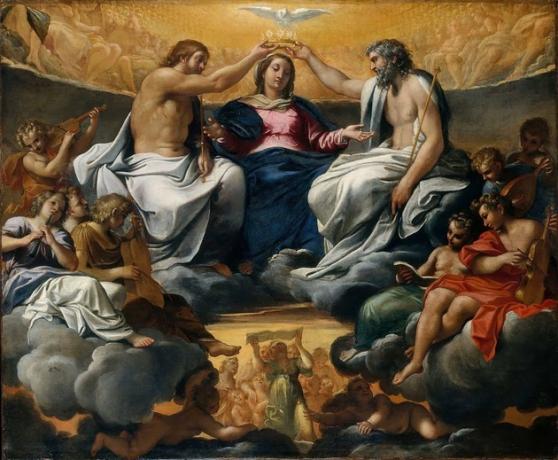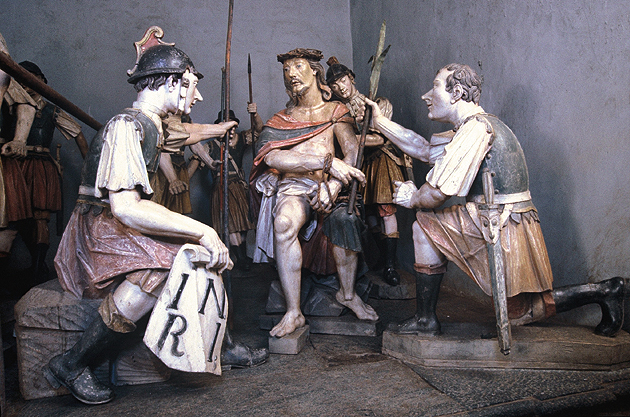THE Baroque art it is known for its exaggerated details, refinement and elegance.
It developed in the 17th century at a very significant time for civilization in the West, because at that time there were major changes that revolutionized the current society.
It first appeared in Italy and soon spread to other European countries. Later, it also developed in Brazil and the rest of the American continent with the arrival of Portuguese and Spanish colonists.
Therefore, it is a movement that is strongly related to the historical circumstances in which it operates.
It appears in the context of the Counter-Reformation and also in the colonialist scenario, with the many riches of royalty in new territories. His works include, above all, religious themes.
Main Characteristics of Baroque Art

Having developed in several places, the Baroque style does not have a homogeneous character. There are several differences between the production carried out by each artist in different locations.
Despite this, some striking features are repeated:
- Predominance of religious themes;
- Wealth in details and forms;
- Dramatic expressions of the portrayed characters;
- Preference for curves and contours over geometric figures;
- Importance of lighting and the play of lights and shadows;
- Use of contrasts in order to demonstrate the proximity of the divine to the human.
Baroque art in Brazil

Scholars claim that it was in the Baroque style when the first truly Brazilian expressions of art appeared.
In Brazil, Baroque has its heyday in the 18th century and lasted until the 19th century. In our country, due to the wealth of the colonial period, we have a remarkable collection of works of Baroque expression.
Here, this style is strongly related to Catholicism. There are many baroque churches, however, it is also possible to find other architectural projects with such characteristics, for example, town halls, penitentiaries and people's homes distinguished.
The greatest icon of baroque art in Brazil was the sculptor Antônio Francisco Lisboa, the cripple (1730-1814). His production ranges from carved wood, soapstone, altars and churches and is characterized by the use of colors and the simple and dynamic way of portraying the scenes.
Strands of Baroque in Brazil
There are two strands within the Baroque art produced on national soil.
THE most exquisite it took place in the states of Minas Gerais, Rio de Janeiro, Pernambuco and Bahia, where the economy was based on sugarcane and mining. In these regions are found churches with woodwork, in which the reliefs were covered by layers of gold. There are also windows and doors that display meticulous sculpture productions.
In the less affluent regions of the country, where there was no sugar or gold production, the Baroque architectural style was more simplified. The churches did not have such elaborate works, as they were performed by less experienced and renowned artists.
Brazilian Cities and the Baroque
Black gold, located in the state of Minas Gerais, maintains a cultural wealth arising from this period. It is the Brazilian city that stands out most in terms of baroque style.
Gold had been discovered in Minas Gerais, which allowed for very rich constructions.

The city of savior is another example of Baroque expression. At that time, it was the capital of Brazil (until 1763). For this reason, in addition to paintings and sculptures, it houses beautiful architectural works. An example is the Governor's Palace.
Baroque art in Europe

On the European continent, Baroque works are more refined than in Brazil.
At Italy, the work of Gian Lorenzo Bernini (1598-1680). He is considered the inaugural artist of Baroque. He was of great importance for being an architect, urban planner, sculptor, decorator and painter. His works can be seen in Rome.
The work The Ecstasy of Saint Teresa it is one of his most impressive sculptures and exalts feeling and drama. In it, Saint Teresa is represented at the moment when an angel strikes blows with an arrow in her chest, which would have caused intense pain, but awakened a mystical experience of love for God.
Stand out in painting, Tintoretto (1515-1549), Andrea Pozzo (1642-1709), Michelangelo Caravaggio (1571-1610) and Annibale Carraci (1560-1609).
The painter Caravaggio he had a production strongly marked by more common themes. He was interested in portraying people of the people, such as musicians, vendors and gypsies. This artist runs away from the concept of classical beauty proposed by the Renaissance, which linked beauty with aristocracy.

Later, the Baroque style was expanding to other European territories and in each one of them, it gained new contours, more in line with the local culture.
At Spain, developed in the decoration of the doors of civil and religious buildings. In painting, he was influenced by the Italian style - especially in the use of light and shadow - but maintained the characteristic realism and technical mastery.
The most prominent painters in this country were El Greco (1541-1614) and Diego Velázquez (1599-1660). Since in the work of El Greco, the verticality has a strong appeal, the figures are elongated and draw a parallel with the spiritualized images of the Byzantine period.
The painter Velasquez, has a production strongly marked by the portrayal of Spanish royalty in the 17th century. However, it also sought to record the daily lives of common people during a certain period.

US Netherlands, the baroque painting was marked by a descriptive character, with scenes from everyday domestic life and a zeal for realism in the representations.
The greatest exponents of this aspect were: Rubens (1577-1640), Frans Hals (1581-1666), Rembrandt (1606-1669) and Vermeer (1632-1675).
the dutch artist Rembrandt is a name famous for the expressive use of light and shadow in compositions, known as luminist style. He explored all the aspects that luminosity can offer, such as contrasts, midtones, dimness and bright lights.
Already Vermeer, worked more intense lighting. The scenes portrayed on his canvases used to be quite bright and had as their motto the life of the Dutch bourgeoisie.

In Portugal,this style was also present and was in force from 1580 until 1756, year of inauguration of Arcadia Lusitânia and when a new style appeared. The most prominent Portuguese sculptor in Baroque art was Machado de Castro (1731-1822).
Baroque Painting and Sculpture
The painting also focused on sacred themes, with many church ceilings painted in the Baroque style.
In sculpture, most of the Baroque works are sacred, which favored the use of materials such as baked clay, cedar and soapstone.

The feature that stands out the most in terms of painting is the play of light and shadow. The presence of a spotlight on the main figure of the work is purposely made to direct the attention of this illuminated figure.
Both in painting and in sculpture, everyday life is portrayed in a real and moving way, where dramatic facial expressions are observed.
In Brazilian baroque, we cannot fail to mention Manuel da Costa Ataide (1762-1830), considered the greatest painter in the area during the colonial period. In sculpture, Aleijadinho plays the role of the greatest representative.
Read more about baroque art:
- Baroque painting
- Baroque Sculpture
Baroque architecture

As a result of the Counter-Reform, in this period the baroque architecture stood out for the construction of several churches. The aim was to propagate Catholicism and, at the same time, reaffirm its power. This was achieved through the display of the built works.
In Brazil, the São Francisco de Assis Church is considered the masterpiece of cripple. Its ceiling was painted by Manuel da Costa Ataide. Its construction began in 1776, but it was only completed 18 years later, in 1794.
Read more about this artistic movement:
- Baroque
- The Language of Baroque
- Baroque Poetry
- Exercises on Baroque



